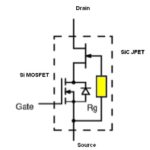Alex Lidow from EPC recently filmed a video with us covering Lidar, a hot subject right now for autonomous vehicles. One of the biggest applications for eGaN is driving these lasers. The reason is that automakers want to see a long distance with a high degree of accuracy. To do that, the laser in a lidar must pump out a lot of photons all at exactly the same moment. When they bounce back, the lidar unit can measure them and determine how far they went before they bounced back.
 But for this sort of time of flight measurement to be accurate, the laser light must all leave it at the same time. In that regard, Lidow says GaN gives incredible high-current pulses with very, very fast rise and fall times, which makes you see farther and see more accurately.
But for this sort of time of flight measurement to be accurate, the laser light must all leave it at the same time. In that regard, Lidow says GaN gives incredible high-current pulses with very, very fast rise and fall times, which makes you see farther and see more accurately.
An EPC demo generated a 25-A pulse less than two nanoseconds in width and a 150-A pulse about six nanoseconds wide. That gives better than a centimeter of resolution at about 300 ft.
There’s some talk in the autonomous vehicle industry that solid-state versions of lidar may be better than motorized versions that provide a 360° view. Both work well, says Lidow, and car companies have a way of grinding down costs. The same can be said for a third type of Lidar, called a flash Lidar, which flashes tiny lasers called VCSELs simultaneously, and then uses a camera chip to receive the reflected light and measure the time of flight. This mode of lidar is good for very high resolution, but the distance is less than 30 m. All three types of Lidar today use GaN transistors because what’s really important is to flash a lot of photons in a super-brief pulse.





Hi, I think it should be “VCSELs” instead of “Vixels”. VCSEL is abbreviation for vertical-cavity surface-emitting laser.
Thank you, Lina. You are correct. (And auto-correct is not!)